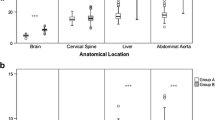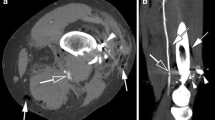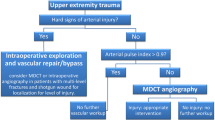Abstract
Purpose
To determine if rapid switching dual-energy CT (rsDECT) provides improvements in vascular attenuation, subjective diagnostic quality, and detection of vascular injuries compared to conventional CT in trauma patients undergoing lower extremity CT angiography.
Materials and methods
The IRB approved this HIPAA-compliant retrospective study. Informed consent was waived. Thirty-nine patients with acute lower extremity trauma including gunshot wounds (19 patients), falls (6 patients), motor vehicle accidents (5 patients), stab wounds (4 patients), pedestrian struck (2 patients), and unspecified trauma (3 patients) who underwent IV contrast-enhanced rsDECT angiography of the lower extremities on a rapid-kilovoltage-switching dual-energy CT scanner (Revolution CT, GE Healthcare) from 6/4/2019 to 1/14/2021 were studied. 7 patients were initially positive for vascular injury on conventional CT, while 32 patients were negative. Blended CT reconstructions simulating conventional 120 kVp single-energy CT, and rsDECT reconstructions (50 keV monoenergetic and iodine density maps) were reviewed. Region of interest contrast density measurements were recorded on conventional and 50 keV reconstructions at multiple levels from the distal aorta to the ankles and compared using Wilcoxon signed‐rank tests. Vascular contrast density of 150 HU was used as a minimum cutoff for diagnostically adequate opacification. Images were interpreted by consensus for subjective image quality and presence of injury on both conventional and DECT reconstructions by two fellowship-trained abdominal radiologists blinded to clinical data, and compared using the paired McNemar test.
Results
Density measurement differences between conventional and rsDECT at every level of the bilateral lower extremities were statistically significant, with the average difference ranging from 304 Hounsfield units (HU) in the distal aorta to 121 HU at the ankles (p < 0.0001). Using a cutoff of 150 HU, 9.5% (93/976) and 3.1% of vascular segments (30/976) were considered non-diagnostic in the conventional and rsDECT groups, respectively, a reduction of 67.7% (p < 0.0001). Subjective image quality between conventional and rsDECT was not statistically significant, but there were 7 vascular segments out of a total of 976 segments across 3 different patients out of a total of 39 patients in which diagnostic quality was upgraded from non-diagnostic on conventional CT to diagnostic on rsDECT, all of which showed suboptimal bolus quality on conventional CT (unmeasurable in 4/7 and ranging from 56–146 HU in the remaining 3). Similarly, rate of injury detection was identical between conventional CT (15/39 patients) and DECT (15/39 patients).
Conclusions
Vascular contrast density is statistically significantly higher with rsDECT compared to conventional CT, and subjective image quality was upgraded from non-diagnostic on conventional CT to diagnostic on rsDECT in 7 vascular segments across 3 patients.
Clinical relevance
rsDECT provides greater vascular contrast density than conventional CT, with potential to salvage suboptimal examinations caused by poor contrast opacification.



Similar content being viewed by others
References
Mackenzie EJ, Fowler CJ (2008) Epidemiology. In: Trauma, 6th ed., Feliciano DV, Mattox KL, Moore EE (Eds), McGraw-Hill Medical, New York. p 25
Snyder WH 3rd, Thal ER, Bridges RA, Gerlock AJ, Perry MO, Fry WJ (1978) The validity of normal arteriography in penetrating trauma. Arch Surg 113(4):424–426. https://doi.org/10.1001/archsurg.1978.01370160082013
Wallin D, Yaghoubian A, Rosing D, Walot I, Chauvapun J, de Virgilio C (2011) Computed tomographic angiography as the primary diagnostic modality in penetrating lower extremity vascular injuries: a level I trauma experience. Ann Vasc Surg 25:620–623
Mishra A, Jain N, Bhagwat A (2017) CT Angiography of peripheral arterial disease by 256-Slice scanner: accuracy, advantages and disadvantages compared to digital subtraction angiography. Vasc Endovascular Surg 51(5):247–254. https://doi.org/10.1177/1538574417698906
Bayraktaroglu S, Cinkooglu A, Ceylan N, Savas R (2020) Salvage of suboptimal enhancement of pulmonary artery in pulmonary CT angiography studies: rapid kVp switch dual energy CT experience. Iran J Radiol 17(2):e97230. https://doi.org/10.5812/iranjradiol.97230
Hamid S, Nasir MU, So A, Andrews G, Nicolaou S, Qamar SR (2021) Clinical applications of dual-energy CT. Korean J Radiol 22(6):970–982. https://doi.org/10.3348/kjr.2020.0996
Wortman JR, Uyeda JW, Fulwadhva UP, Sodickson AD (2018) Dual-energy CT for abdominal and pelvic trauma. Radiographics 38(2):586–602. doi:https://doi.org/10.1148/rg.2018170058
Jia X, Li X, Li J, Tian Q, Yao Y, Zhu S, Sun J, Li Y, Zhao L, Shi Y, Tong W, Yang J, Guo J (2020) Improving diagnostic accuracy for arteries of lower extremities with dual-energy spectral CT imaging. Eur J Radiol 128:109061. https://doi.org/10.1016/j.ejrad.2020.109061
Foster BR, Anderson SW, Uyeda JW, Brooks JG, Soto JA (2011) Integration of 64-detector lower extremity CT angiography into whole-body trauma imaging: feasibility and early experience. Radiology 261(3):787–795. https://doi.org/10.1148/radiol.11100604
Heijenbrok-Kal MH, Kock MC, Hunink MG (2007) Lower extremity arterial disease: multidetector CT angiography meta-analysis. Radiology 245(2):433–439. https://doi.org/10.1148/radiol.2451061280
Kalisz K, Buethe J, Saboo SS, Abbara S, Halliburton S, Rajiah P (2016) Artifacts at cardiac CT: physics and solutions. Radiographics 36(7):2064–2083. https://doi.org/10.1148/rg.2016160079
Author information
Authors and Affiliations
Corresponding author
Ethics declarations
Conflict of interest
The authors declare that they have no conflict of interest.
Additional information
Publisher's Note
Springer Nature remains neutral with regard to jurisdictional claims in published maps and institutional affiliations.
Rights and permissions
About this article
Cite this article
Joshi, R., LeBedis, C., Dao, K. et al. Dual energy CT angiography for lower extremity trauma: comparison with conventional CT. Emerg Radiol 29, 471–477 (2022). https://doi.org/10.1007/s10140-022-02037-1
Received:
Accepted:
Published:
Issue Date:
DOI: https://doi.org/10.1007/s10140-022-02037-1




